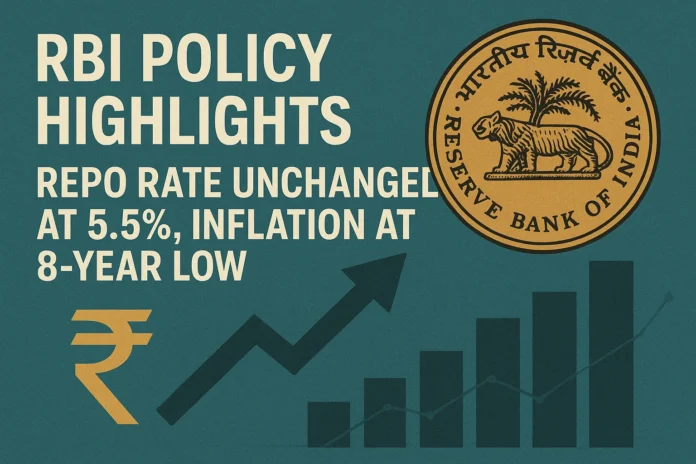Repo Rate Holds Steady at 5.5%
The Reserve Bank of India (RBI) wrapped up its latest Monetary Policy Committee (MPC) meeting from September 29 to October 1, 2025. The big takeaway? No change in interest rates.
- Repo Rate: 5.5% (the rate banks borrow from RBI)
- Standing Deposit Facility (SDF): 5.25%
- Marginal Standing Facility (MSF) & Bank Rate: 5.75%
The MPC kept its stance neutral, signaling that it isn’t leaning toward hiking or cutting rates anytime soon.
Why it matters: The repo rate sets the tone for borrowing costs across the country. Lower rates mean cheaper loans for homes, cars, and businesses, while higher rates slow down spending. By keeping it unchanged, RBI is opting for stability.
Inflation Trends: How Low is Low?
Inflation is cooling off in India.
- July 2025: 1.6%
- August 2025: 2.1%
- FY26 Forecast: Revised down to 2.6% from 3.7%
The main reason? Food prices. A good monsoon, strong kharif sowing, and stable grain stocks have kept prices in check. Plus, the recent GST rationalisation has made everyday items more affordable.
Investor Insight: Low and steady inflation is great news for bonds and equities, especially in consumption-driven sectors.
Growth Outlook: India’s Economy Shows Resilience
India’s GDP growth remains robust:
- Q1 FY26: 7.8%
- Full-year FY26 projection: 6.8%
Private consumption, investments, and the services sector are driving growth, thanks to urban demand and a healthy monsoon.
Quarterly Projections:
- Q2 FY26: 7.0%
- Q3 FY26: 6.4%
- Q4 FY26: 6.2%
Risks: Global trade tensions, volatile financial markets, and geopolitical uncertainties could temper external demand. Foreign investors have already pulled out ~$3.9B this year.
Why RBI Chose a “Neutral” Stance
Even with inflation at multi-year lows, RBI is holding off on rate cuts. The central bank prefers to monitor the effects of past policy moves and fiscal measures before making new changes.
In short: RBI values stability over speed, especially with global uncertainties looming.
RBI Policy 2025: Key Banking, Credit, and Rupee Reforms
Beyond interest rates, RBI rolled out 22 measures to strengthen the financial system. Here are the highlights:
- Banking Reforms: New provisioning norms (ECL framework), Basel III capital rule revisions, risk-based deposit insurance.
- Credit Flow: Higher lending limits against shares, IPO financing, and support for corporate borrowing.
- Ease of Doing Business: Simplified ~9,000 RBI circulars, relaxed current account rules, extended timelines for exporters.
- Consumer Protection: Improved digital banking services, stronger ombudsman mechanisms, coverage for rural cooperative banks.
- Rupee Internationalisation: Cross-border lending in rupees, enabling rupee balances for corporate bond investment, transparent reference rates.
These reforms may not shake the market immediately but signal long-term benefits for banks, NBFCs, infrastructure finance, and the rupee’s global role.
What This Means for Investors
Here’s the bottom line:
- Borrowing costs remain steady.
- Inflation is low and predictable, supporting bond and equity markets.
- Domestic growth is strong, particularly in services, consumption, and infrastructure.
- Structural reforms are positive for financial stability and the rupee.
- Global risks persist, potentially affecting exporters and market sentiment.
Conclusion
RBI’s cautious approach—holding rates steady while keeping an eye on global and domestic trends—signals a period of stability. For investors, this means:
- Comfort from low inflation
- Predictable borrowing costs
- Long-term gains from structural reforms
Even as the world remains uncertain, India’s economic fundamentals continue to look strong.


